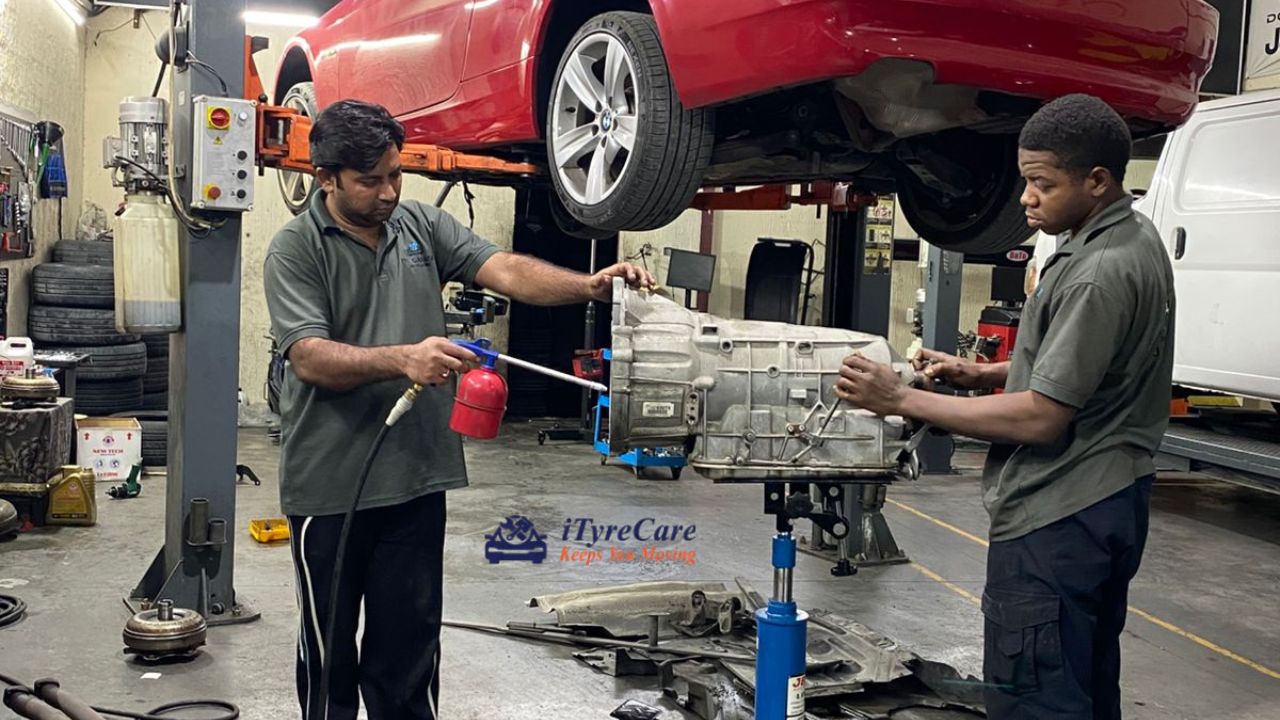The Ultimate Guide to Car Repairing

Strong8k brings an ultra-HD IPTV experience to your living room and your pocket.
Introduction
Car repair is an essential skill for any vehicle owner. Whether it's regular maintenance,
troubleshooting issues, or conducting major repairs, understanding how your car works and how to fix it can save time, money, and stress. This article provides an in-depth guide to car
repairing, covering essential tools, common problems, and practical solutions.
Why Learn Car Repair?
Understanding car repair offers numerous benefits:
1. Cost Savings: Professional car repairs can be expensive. Learning to handle minor
issues on your own can save hundreds, if not thousands, of dollars annually.
2. Convenience: Fixing a car problem yourself can be faster than waiting for a mechanic,
especially for small issues.
3. Empowerment: Knowing how to handle car problems gives you confidence and reduces
dependence on external help.
4. Preventative Maintenance: Recognizing warning signs early can prevent more
significant and costly repairs down the line.
5. Longevity of the Vehicle: Proper repairs and maintenance ensure that your car lasts
longer, maintaining its performance over the years.
6. Environmental Impact: A well-maintained car runs more efficiently, reducing emissions
and fuel consumption.
Essential Tools for Car Repair
Before diving into repairs, ensure you have the necessary tools. Here's a list of must-haves for your toolkit:
1. Socket Set: For loosening and tightening bolts and nuts.
2. Screwdrivers: A set of flathead and Phillips screwdrivers of varying sizes.
3. Jack and Jack Stands: To lift the car safely off the ground.
4. Wrenches: Open-end and adjustable wrenches for various sizes.
5. Pliers: Needle-nose, locking, and standard pliers for gripping and bending.
6. Torque Wrench: To tighten bolts to the manufacturer's specifications.
7. Multimeter: For diagnosing electrical issues.
8. Oil Filter Wrench: For removing and installing oil filters.
9. Diagnostic Scanner: To read error codes and identify problems.
10. Work Light: For visibility when working in dark spaces.
11. Brake Bleeder Kit: Essential for brake maintenance.
12. Tire Pressure Gauge: To monitor and maintain the correct tire pressure.
13. Rubber Mallet: Useful for tasks requiring gentle but firm tapping.
Common Car Problems and Their Fixes
1. Flat Tire
A flat tire is one of the most common car issues. Here's how to fix it:
● What You'll Need: Spare tire, lug wrench, jack, and tire iron.
● Steps:
1. Park the car on a flat surface and engage the parking brake.
2. Loosen the lug nuts with the wrench.
3. Use the jack to lift the car.
4. Remove the lug nuts and take off the flat tire.
5. Mount the spare tire and tighten the lug nuts by hand.
6. Lower the car and fully tighten the lug nuts with the wrench.
2. Dead Battery
A dead battery can leave you stranded, but jump-starting the car is straightforward.
● What You'll Need: Jumper cables and a second vehicle with a charged battery.
● Steps:
1. Position the cars close together but avoid them touching.
2. Connect the positive (red) cable to the dead battery's positive terminal.
3. Connect the other end of the positive cable to the good battery's positive
terminal.
4. Connect the negative (black) cable to the good battery's negative terminal.
5. Attach the other end of the negative cable to an unpainted metal surface on the
dead car.
6. Start the working car and let it run for a few minutes.
7. Attempt to start the dead car.
8. Once started, remove the cables in reverse order.
3. Overheating Engine
An overheating engine can cause severe damage if not addressed quickly.
● What You'll Need: Coolant and a rag.
● Steps:
1. Pull over and turn off the engine immediately.
2. Let the engine cool down for at least 30 minutes.
3. Check the coolant level in the reservoir.
4. If low, add coolant to the reservoir but never open a hot radiator cap.
5. Inspect for leaks or damaged hoses.
6. If overheating persists, consult a mechanic.
4. Brake Issues
Spongy or unresponsive brakes can compromise safety.
● What You'll Need: Brake fluid, wrench, and a bleeder kit.
● Steps:
1. Check the brake fluid level in the master cylinder.
2. If low, top it up with the recommended brake fluid.
3. Inspect brake pads and rotors for wear.
4. Bleed the brakes if there is air in the brake lines.
5. Check Engine Light
The check engine light indicates a variety of issues.
● What You'll Need: Diagnostic scanner.
● Steps:
1. Connect the scanner to the OBD-II port (usually under the dashboard).
2. Retrieve error codes.
3. Refer to the car’s manual or online resources to interpret the codes.
4. Address the underlying issue (e.g., replace spark plugs, tighten the gas cap).
6. Faulty Alternator
A failing alternator can cause a drained battery and electrical issues.
● What You'll Need: Multimeter.
● Steps:
1. Check the battery voltage with a multimeter; it should read 12.6 volts when the
car is off and around 13.7-14.7 volts when running.
2. If the alternator isn’t charging the battery, replace it or consult a mechanic.
7. Fuel System Problems
Clogged fuel filters or failing fuel pumps can cause poor performance.
● What You'll Need: Fuel pressure gauge and replacement filters.
● Steps:
1. Test fuel pressure at the fuel rail.
2. Replace the fuel filter if it’s clogged.
3. If the fuel pump is failing, it might need professional replacement
.
Preventative Maintenance
Preventative maintenance can extend the lifespan of your car and reduce repair costs. Here are essential maintenance tasks:
1. Oil Changes: Replace engine oil and filter every 3,000 to 5,000 miles, depending on
your car’s specifications.
2. Tire Maintenance: Rotate tires every 6,000 miles and maintain proper air pressure.
3. Brake Checks: Inspect brake pads and fluid regularly.
4. Fluid Levels: Monitor and top up coolant, transmission, and windshield washer fluids.
5. Battery Care: Clean terminals and check voltage periodically.
6. Belt and Hose Inspection: Look for cracks, fraying, or wear and replace as needed.
7. Filter Replacement: Change air and fuel filters according to the manufacturer’s
recommendations.
8. Alignment and Suspension Checks: Misalignment can lead to uneven tire wear.
9. Spark Plug Replacement: Replace spark plugs as recommended to ensure smooth
engine performance.
10. Inspect Seals and Gaskets: Look for oil leaks and replace damaged gaskets.
When to Consult a Professional
While DIY car repair can handle many issues, some problems require professional expertise.
Consult a mechanic if:
1. The issue is beyond your skill level or requires specialized tools.
2. You’re dealing with major engine or transmission problems.
3. There’s a persistent electrical issue you can’t diagnose.
4. Safety systems like airbags or ABS are malfunctioning.
5. You notice unusual noises, smells, or vibrations that persist despite initial checks.
Safety Tips for Car Repair
1. Always wear safety goggles and gloves when working on your car.
2. Use jack stands to support the car, never rely solely on a jack.
3. Work in a well-ventilated area, especially when dealing with chemicals or running the
engine.
4. Disconnect the battery before working on electrical components.
5. Keep a fire extinguisher nearby in case of emergencies.
6. Ensure you have a first aid kit in case of minor injuries.
7. Avoid wearing loose clothing or jewelry that could get caught in moving parts.
8. Double-check the vehicle’s stability before working underneath it.
Conclusion
Car repairing is a valuable skill that empowers vehicle owners to maintain their cars, save money, and gain confidence. By equipping yourself with the right tools, understanding common issues, and practicing preventative maintenance, you can keep your car in top condition. While some repairs require professional help, many can be handled with patience and effort. Whether you’re a beginner or an experienced DIYer, investing time in learning car repair is a decision that pays off in the long run.
The journey of mastering car repair is ongoing. As technology evolves, staying informed about modern systems like electric vehicles and advanced diagnostics is crucial. With dedication and practice, anyone can become proficient in car repair, ensuring a safer and more reliable driving experience.
Note: IndiBlogHub features both user-submitted and editorial content. We do not verify third-party contributions. Read our Disclaimer and Privacy Policyfor details.







